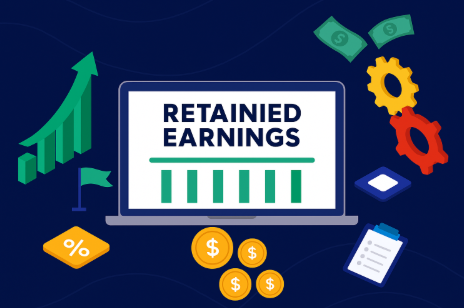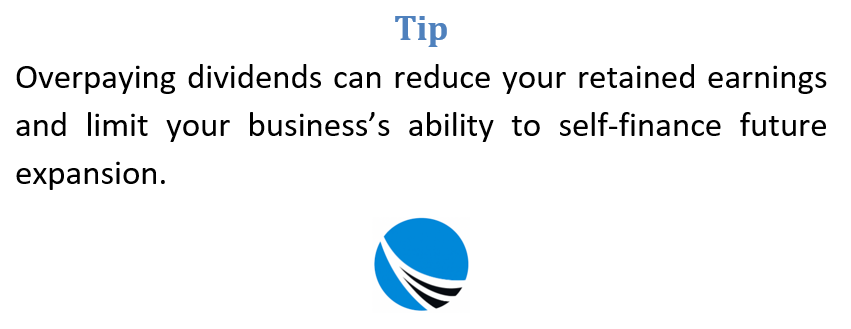Retained earnings are one of the most crucial financial concepts for any business to grasp, especially for entrepreneurs aiming to scale operations, attract investors, or simply run a financially sound enterprise. While many associate profits with instant spending power, retained earnings represent a deeper, strategic way of thinking about business success. This article will explore the concept of retained earnings, its significance in financial planning, how it appears in financial statements, and how to calculate and interpret it effectively.
What Retained Earnings Really Represent
Retained earnings refer to the portion of a company’s net income that is not distributed to shareholders or owners as dividends but is instead kept or “retained” within the business. This amount accumulates over time, and companies can use it for future investments, debt reduction, operational expansion, or building financial stability.
In practical terms, retained earnings are the cumulative total of net profits that remain in the business after accounting for all expenses, including operational costs, taxes, and dividend payouts. They act as a bridge between past profits and future growth opportunities.

Why Retained Earnings Matter to Your Business
For any business aiming for long-term growth and financial autonomy, retained earnings are a vital internal source of funding. Unlike loans or equity investments, they do not require approval from external entities and come with no repayment terms or interest obligations.
Small businesses, in particular, benefit from retained earnings because it offers a flexible way to reinvest in tools, property, human resources, and innovation. It can also cushion the business during low-income periods, helping to maintain stability without seeking emergency financing.
For young startups or sole proprietorships, retained earnings may initially be minimal. Nevertheless, tracking this figure helps instill good accounting practices and provides a clearer picture of profitability and operational efficiency over time.
The Impact on Financial Statements
Although retained earnings might not be immediately visible in daily business operations, they are a key component of a company’s financial health. They typically appear in the equity section of the balance sheet, distinguishing them from cash assets or liabilities.
Here’s how they relate to your core financial statements:
- Balance Sheet: Retained earnings are recorded under the owner’s equity section and represent the cumulative total of earnings that have been reinvested rather than paid out.
- Income Statement: While the income statement reflects profits and losses within a specific period, retained earnings are not itemized here. Instead, net income from the income statement contributes to the change in retained earnings.
- Cash Flow Statement: There’s no direct line item for retained earnings, but this figure can be influenced by financing and operational activities noted in the cash flow.
In essence, retained earnings serve as a historical log of profit reinvestment, reflecting how much the business has decided to retain and build upon over time.
Distinguishing Retained Earnings from Business Reserves
A common misconception is that retained earnings and reserves are interchangeable. While both relate to accumulated profits, they differ in function and reporting.
Retained earnings represent the overall profit retained by the business after dividends. Reserves, on the other hand, are allocations made from retained earnings for specific purposes—such as future tax liabilities, anticipated repairs, or acquisitions.
Reserves are often listed under liabilities or as dedicated subcategories of equity, indicating that the funds have a predetermined use. Retained earnings, however, remain unrestricted until the business decides how to allocate or spend them.

Properly Recording Retained Earnings in Your Books
Accurate accounting of retained earnings is essential for presenting a complete picture of your company’s financial position. It’s important to understand that retained earnings do not equate to available cash in your bank account.
The amount recorded as retained earnings is not necessarily liquid. It could be tied up in equipment, inventory, or other long-term assets. Therefore, it’s crucial to treat it as an equity figure—not an immediate spending resource.
When updating your accounting records, retained earnings should be adjusted at the end of each financial period to include the most recent net income and to subtract any dividends paid. This way, the figure always reflects the current state of reinvested profit.
The Role of Retained Earnings in Forecasting and Strategic Planning
For businesses looking to attract investors, apply for financing, or develop growth strategies, projecting retained earnings can be incredibly valuable. Retained earnings indicate your company’s ability to generate and preserve profits over time—a key factor in financial forecasting.
Potential investors and lenders often examine the retained earnings figure to assess how well a company manages its profit. A growing retained earnings figure signals operational efficiency and disciplined reinvestment. Conversely, consistently negative retained earnings may indicate that the company struggles with profitability or distributes excessive dividends.
Including retained earnings in your financial projections can also help internal stakeholders gauge how much funding may be available for future investments without external borrowing.
How to Calculate Retained Earnings
Calculating retained earnings is relatively straightforward if you have access to your income statement and balance sheet. Use the following formula:
Retained Earnings = Previous Retained Earnings + Net Profit (or Loss) – Dividends Paid
Let’s break this down step by step using an example:
Step 1: Review Previous Retained Earnings
Start with the retained earnings reported at the end of the last financial period. Suppose your business had $15,000 in retained earnings at the end of the previous quarter.
Step 2: Add Net Income
Next, take the net income figure from your income statement for the current period. Assume your business earned a net income of $6,000 in the current quarter.
Step 3: Subtract Dividends
If you paid dividends to shareholders or owners, subtract that amount from the sum. If $2,000 was distributed, deduct it accordingly.
Step 4: Final Calculation
Using the formula:
$15,000 (Opening Retained Earnings) + $6,000 (Net Income) – $2,000 (Dividends) = $19,000 (New Retained Earnings)
This figure will now appear in the equity section of your balance sheet for the current quarter.
Optional: Creating a Retained Earnings Statement
In addition to traditional financial statements, some businesses opt to prepare a separate retained earnings statement. This document is typically brief and includes:
- Beginning retained earnings balance
- Net income or loss
- Dividend distributions
- Ending retained earnings balance
While optional, this statement is useful for transparency, especially when seeking investment or presenting financial reports to external stakeholders.
How Retained Earnings Help During Tough Times
Retained earnings are more than a number on a sheet—they offer a safety net when times get rough. During economic slowdowns or seasonal sales dips, these funds can help cover expenses without seeking costly short-term loans or making rushed cuts to operations.
Businesses that routinely allocate a portion of net profits to retained earnings find themselves more resilient. They can afford to take calculated risks, sustain payroll during downturns, and weather market fluctuations more confidently.
Common Pitfalls to Avoid
While the concept is simple, businesses often make avoidable errors when dealing with retained earnings:
- Confusing Retained Earnings with Cash Flow: A high retained earnings figure does not necessarily mean cash is available. Be aware of how assets are tied up.
- Ignoring It Altogether: Some small businesses never track retained earnings formally, missing out on valuable insight into financial performance and planning.
- Over-distribution of Dividends: Paying excessive dividends can drain your ability to reinvest or buffer against downturns.
- Failure to Adjust for Net Losses: Always update retained earnings to reflect losses as well as profits, or the figure may become misleading.
Final Thoughts on Retained Earnings
Retained earnings may seem like a dry accounting term, but in reality, they represent one of the clearest indicators of a business’s financial discipline and growth potential. Tracking and understanding this figure empowers business owners to make informed decisions about reinvestment, risk-taking, and long-term strategy.
By routinely calculating and analyzing retained earnings, you give yourself a clearer roadmap of where your business has been and where it’s headed. For entrepreneurs, this number tells a story of resilience, growth, and financial control—qualities that investors, lenders, and partners deeply value.
As your business evolves, so will your retained earnings. Treat it as a strategic asset, and it can become a cornerstone of your financial success.
Frequently Asked Questions about Retained Earnings
What Are Retained Earnings?
Retained earnings are the portion of a company’s net profits that are kept in the business after dividends are paid, used for reinvestment or debt repayment.
Why Are Retained Earnings Important?
They provide a self-financing option for growth, reduce reliance on external funding, and reflect the company’s financial health over time.
How Do Retained Earnings Differ from Net Income?
Net income is the profit for a single period, while retained earnings accumulate profits across multiple periods after dividend payouts.
Where Are Retained Earnings Reported?
They appear in the equity section of the balance sheet, not as an asset or cash figure, and are updated each accounting period.
Can Retained Earnings Be Spent Directly?
No, they are not a liquid asset. Though they reflect profits, the money may be reinvested or tied up in other business areas.
Are Retained Earnings and Reserves the Same?
No. Reserves are specific allocations of retained earnings for designated purposes, while retained earnings are general reinvested profits.
How Do You Calculate Retained Earnings?
Use the formula: Opening Retained Earnings + Net Income – Dividends Paid. This updates the balance each accounting period.

